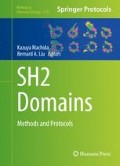Abstract
Recombinant modular protein domains have been a convenient proteomics tool for deciphering protein-protein interactions and elucidating the role of protein modifications in cell signaling. To obtain reliable experimental data, these protein domain probes require sufficient specificity and sensitivity. Since naturally evolved protein domains do not always have optimal biochemical characteristics for in vitro assays, functional alterations such as improved affinity are sometimes needed. In this chapter, we describe preparation of loss-of-function and concatenated (tandem) SH2 domains that should be widely applicable to both high- and low-throughput phosphoproteomics studies.
Access this chapter
Tax calculation will be finalised at checkout
Purchases are for personal use only
References
Jadwin JA, Ogiue-Ikeda M, Machida K (2012) The application of modular protein domains in proteomics. FEBS Lett 586(17):2586–2596. doi:10.1016/j.febslet.2012.04.019
Mayer BJ (2015) The discovery of modular binding domains: building blocks of cell signalling. Nat Rev Mol Cell Biol 16(11):691–698. doi:10.1038/nrm4068
Jones RB, Gordus A, Krall JA, MacBeath G (2006) A quantitative protein interaction network for the ErbB receptors using protein microarrays. Nature 439(7073):168–174. doi:10.1038/nature04177
Machida K, Thompson CM, Dierck K, Jablonowski K, Karkkainen S, Liu B, Zhang H, Nash PD, Newman DK, Nollau P, Pawson T, Renkema GH, Saksela K, Schiller MR, Shin DG, Mayer BJ (2007) High-throughput phosphotyrosine profiling using SH2 domains. Mol Cell 26(6):899–915. doi:10.1016/j.molcel.2007.05.031
Chen X, Tan PH, Zhang Y, Pei D (2009) On-bead screening of combinatorial libraries: reduction of nonspecific binding by decreasing surface ligand density. J Comb Chem 11(4):604–611. doi:10.1021/cc9000168
Hause RJ Jr, Leung KK, Barkinge JL, Ciaccio MF, Chuu CP, Jones RB (2012) Comprehensive binary interaction mapping of SH2 domains via fluorescence polarization reveals novel functional diversification of ErbB receptors. PLoS One 7(9), e44471. doi:10.1371/journal.pone.0044471
Liu BA, Engelmann BW, Jablonowski K, Higginbotham K, Stergachis AB, Nash PD (2012) SRC homology 2 domain binding sites in insulin, IGF-1 and FGF receptor mediated signaling networks reveal an extensive potential interactome. Cell Commun Signal 10(1):27. doi:10.1186/1478-811x-10-27
Takakuma K, Ogo N, Uehara Y, Takahashi S, Miyoshi N, Asai A (2013) Novel multiplexed assay for identifying SH2 domain antagonists of STAT family proteins. PLoS One 8(8), e71646. doi:10.1371/journal.pone.0071646
Liu H, Li L, Voss C, Wang F, Liu J, Li SS (2015) A comprehensive immunoreceptor phosphotyrosine-based signaling network revealed by reciprocal protein-peptide array screening. Mol Cell Proteomics 14(7):1846–1858. doi:10.1074/mcp.M115.047951
Dierck K, Machida K, Voigt A, Thimm J, Horstmann M, Fiedler W, Mayer BJ, Nollau P (2006) Quantitative multiplexed profiling of cellular signaling networks using phosphotyrosine-specific DNA-tagged SH2 domains. Nat Methods 3(9):737–744. doi:10.1038/nmeth917
Machida K, Khenkhar M, Nollau P (2012) Deciphering phosphotyrosine-dependent signaling networks in cancer by SH2 profiling. Genes Cancer 3(5-6):353–361. doi:10.1177/1947601912459048
Saito Y, Furukawa T, Arano Y, Fujibayashi Y, Saga T (2010) Fusion protein based on Grb2-SH2 domain for cancer therapy. Biochem Biophys Res Commun 399(2):262–267. doi:10.1016/j.bbrc.2010.07.066
Mayer BJ, Jackson PK, Van Etten RA, Baltimore D (1992) Point mutations in the abl SH2 domain coordinately impair phosphotyrosine binding in vitro and transforming activity in vivo. Mol Cell Biol 12(2):609–618
Kuriyan J, Cowburn D (1997) Modular peptide recognition domains in eukaryotic signaling. Annu Rev Biophys Biomol Struct 26:259–288. doi:10.1146/annurev.biophys.26.1.259
Campbell SJ, Jackson RM (2003) Diversity in the SH2 domain family phosphotyrosyl peptide binding site. Protein Eng 16(3):217–227
Lappalainen I, Thusberg J, Shen B, Vihinen M (2008) Genome wide analysis of pathogenic SH2 domain mutations. Proteins 72(2):779–792. doi:10.1002/prot.21970
Filippakopoulos P, Muller S, Knapp S (2009) SH2 domains: modulators of nonreceptor tyrosine kinase activity. Curr Opin Struct Biol 19(6):643–649. doi:10.1016/j.sbi.2009.10.001
Gan W, Roux B (2009) Binding specificity of SH2 domains: insight from free energy simulations. Proteins 74(4):996–1007. doi:10.1002/prot.22209
Zheng L, Baumann U, Reymond JL (2004) An efficient one-step site-directed and site-saturation mutagenesis protocol. Nucleic Acids Res 32(14), e115. doi:10.1093/nar/gnh110
Liu BA, Jablonowski K, Raina M, Arce M, Pawson T, Nash PD (2006) The human and mouse complement of SH2 domain proteins-establishing the boundaries of phosphotyrosine signaling. Mol Cell 22(6):851–868. doi:10.1016/j.molcel.2006.06.001
Ko JK, Ma J (2005) A rapid and efficient PCR-based mutagenesis method applicable to cell physiology study. Am J Physiol Cell Physiol 288(6):C1273–C1278. doi:10.1152/ajpcell.00517.2004
Acknowledgements
We thank Joshua Jadwin and Silas Khong Ng for assistance with editing the chapter, and Bruce Mayer for his continuous encouragement and support. This study was partly supported by grant CA1154966 from the National Institutes of Health and Quest for CURES (QFC) grant from the Leukemia and Lymphoma Society (to K.M.).
Author information
Authors and Affiliations
Corresponding author
Editor information
Editors and Affiliations
Rights and permissions
Copyright information
© 2017 Springer Science+Business Media LLC
About this protocol
Cite this protocol
Ogiue-Ikeda, M., Machida, K. (2017). Functionally Altered SH2 Domains for Biochemical Studies: Loss-of-Function Mutant and Domain Concatenation. In: Machida, K., Liu, B. (eds) SH2 Domains. Methods in Molecular Biology, vol 1555. Humana Press, New York, NY. https://doi.org/10.1007/978-1-4939-6762-9_12
Download citation
DOI: https://doi.org/10.1007/978-1-4939-6762-9_12
Published:
Publisher Name: Humana Press, New York, NY
Print ISBN: 978-1-4939-6760-5
Online ISBN: 978-1-4939-6762-9
eBook Packages: Springer Protocols

